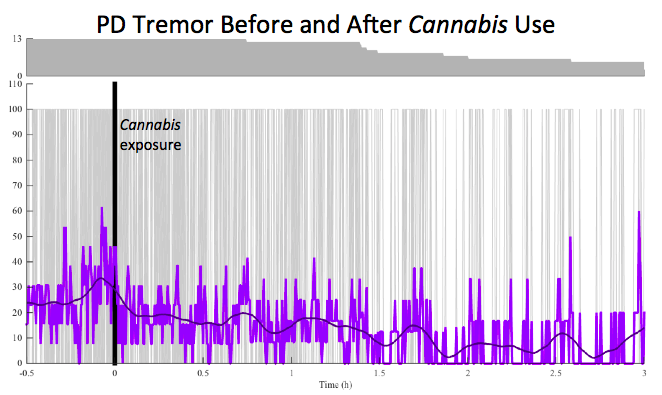Session Information
Date: Tuesday, June 6, 2017
Session Title: Tremor
Session Time: 1:45pm-3:15pm
Location: Exhibit Hall C
Objective: The purpose of this study was to describe the effect of Cannabis on Parkinson’s disease (PD) tremor using advanced motion detection technology and qualitative interviews.
Background: In a survey of PD patients in Europe, 25% of participants reported Cannabis use and of those, 31% reported improvement of resting tremor (Venderova et al, 2004). Furthermore, a small, open-label, observational study of patients reporting severe PD-related pain and tremor not controlled with medication experienced significant improvements in tremor and rigidity by smoking Cannabis (Lotan et al., 2014). To date, the impact of Cannabis on PD tremor has never been formally evaluated using motion sensors or qualitative methodology.
Methods: Individuals with PD who were using Cannabis according to Washington state law were asked to wear a movement monitor provided by APDM for 14 days. The frequency and amplitude of the tremor were recorded during all waking hours. During this observational study, participants were asked to alert the motion sensor by pressing a button each time Cannabis was used. The difference in tremor duration and magnitude for the one hour before compared to one after Cannabis was reported.
Results: The motion sensor detected a tremor in two participants lasting 34.4% and 17.8% of the total duration they wore the watch over the 14 days. The other 8 participants exhibited a tremor less than 4% of the duration of the study. Of the 2 subjects with the most notable tremors, Cannabis was shown to reduce the detection of the tremor 11.97% and 13.02% when comparing the tremor one hour before and one hour after Cannabis use (p=0.009 and 0.013 respectively). The subject exhibiting a tremor for 34.4% of the time also had a statistically significant reduction in the magnitude of the tremor (-0.592; p=0.000).
Conclusions: Most of the subjects recruited for this study had a very mild intermittent tremor that could not be reliably detected by the motion sensor. None of the subjects showed an increase in detectable tremor or tremor magnitude following a Cannabis intervention. In the two subjects that had a tremor of sufficient severity and persistence, there was a consistent decrease in the tremor persistence and in detected tremor magnitude. In the future, subjects with a more pronounced tremor should be recruited and consistent Cannabis strains, doses, and delivery system should be used for uniform comparison across subjects.
References: Lotan I, Treves TA, Roditi Y, Djaldetti R. (2014). Cannabis (medical marijuana) treatment for motor and non-motor symptoms of Parkinson disease: an open-label observational study. Clinical Neuropharmacology;37:41-44
Venderova K, Ruzicka E, Vorisek V, Visnovsky P. (2004). Survey on cannabis use in Parkinson’s disease: subjective improvement of motor symptoms. Movement Disorders;19:1102-1106.
To cite this abstract in AMA style:
L. Mischley, R. Bennett, M. Sexton, G. Ricciardi, J. McNames. Cannabis and Parkinson’s Disease Tremor [abstract]. Mov Disord. 2017; 32 (suppl 2). https://www.mdsabstracts.org/abstract/cannabis-and-parkinsons-disease-tremor/. Accessed December 20, 2025.« Back to 2017 International Congress
MDS Abstracts - https://www.mdsabstracts.org/abstract/cannabis-and-parkinsons-disease-tremor/

